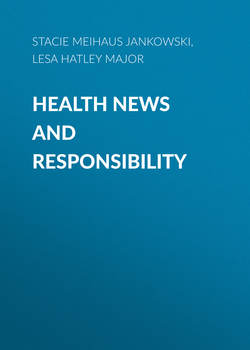Читать книгу Health News and Responsibility - Lesa Hatley Major - Страница 10
На сайте Литреса книга снята с продажи.
ОглавлениеPreface
Several years ago I was presenting my research on the effects of episodic and thematic frames in health news. The audience was colleagues, including professors and practitioners, and graduate students from the journalism program at Indiana University in Bloomington. As I was explaining my work defining episodic and thematic frames and their connection to attribution of responsibility, I watched the facial expressions of the people attending my lecture.
Like most people, who present or perform in front of audiences, I was trying to read the room. Searching the faces for comprehension, confusion, agreement, disagreement, etc. I noticed one of my colleagues, a Pulitzer prize winning journalist, nodding in agreement with how I was describing thematic and episodic framing. I was explaining how journalists use these frames in news to cover health issues by focusing on individual stories of success or failure sometimes combined with details that offer a broader context about these same issues–statistics about how many people are affected, and how these issues could be addressed by policy. He remained genuinely interested throughout the presentation.
After the talk was finished, this colleague approached me to discuss my research. He started with the comment, “that’s exactly what we do. That’s how we cover issues.” It was my turn to nod my head in agreement and answer “I know.” I worked as a journalist before entering academia. I had the same reaction when I first read Iyengar’s 1991 book, Is Anyone Responsible: How Television Frames ←xi | xii→Political Issues, about episodic and thematic frames and attribution of responsibility. My dissertation advisor, another former journalist, assigned the book for me to read. She said, “You are going to like this. He gets us.” I did like it. It made sense to me. When I read it, I realized I knew what these frames were because as a journalist I used them all of the time.
My experience as a journalist influences my work as a health communication researcher. Journalists use thematic and episodic frames in news coverage. As researchers we need to examine the frames journalists use in their stories. Even if these frames are not shiny and new. Like most social issues, successful attempts to address public health problems involve public policy solutions. Public opinion support is necessary for public policy. Public support for policy requires the public to understand society’s role in solving problems.
Thematic and episodic frames are directly connected to attribution of responsibility. Along with the who, what, when, where, and why in news stories, identifying the causes of problems, and who or what is responsible for solving problems remains one of the most important functions of journalists. Attribution of responsibility influences the political agenda, public opinion, and public support for policies dealing with issues and problems.
In this book, we examine 25 years of research on thematic and episodic frames in health news. We have two goals in this project. First, to examine and explain what we know about the research on these frames in health to this point, and to provide a framework for research on thematic and episodic frames in health news in terms of public opinion support for health policy.
We plan to share our work with other health communication scholars, public health scholars and practitioners, and journalists reporting on health issues. All of us need to work together to understand the process and power of news frames. In many ways, that is where the real work begins.
Lesa Hatley Major
←xii | xiii→
